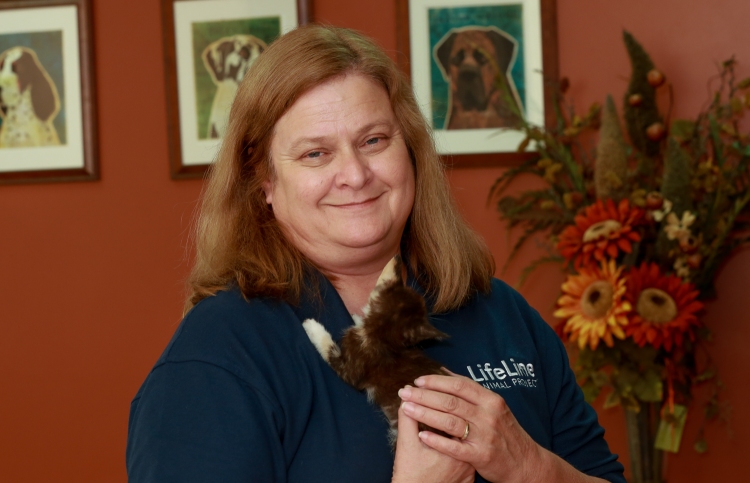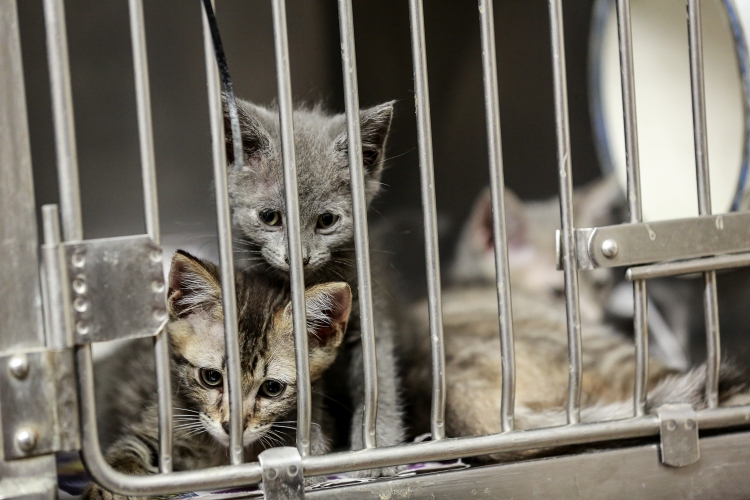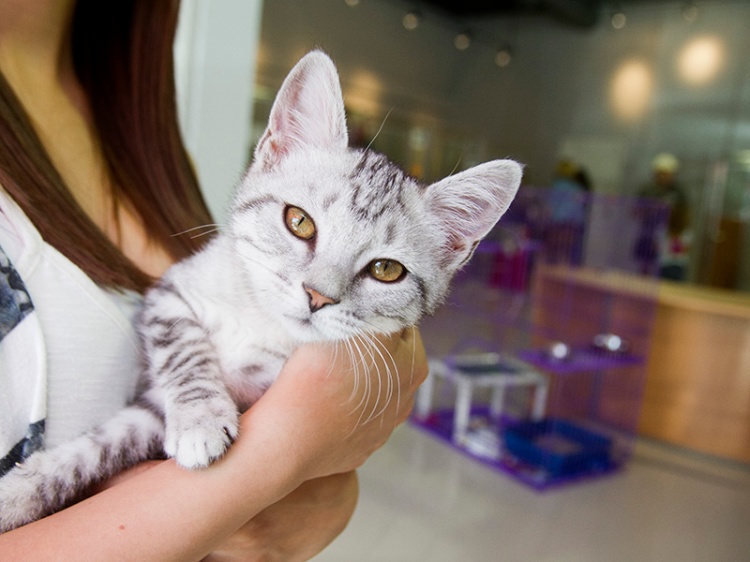Rebecca Guinn remembers that ah-ha moment as if it were yesterday. Standing in the middle of the “stray ward” at the Dekalb County Animal Services shelter in Atlanta, she couldn’t believe her eyes – the kennel was practically empty. There to save a stray dog she’d reported to Animal Control after he’d gotten caught in a fence behind her home, Guinn decided to adopt him after finding out he would soon be euthanized if no one claimed him. Just days earlier, when she’d first visited the facility to put her name on his kennel card, the shelter had been jam-packed with hundreds of desperate, barking dogs. Where had they gone?
“The dog I wanted to save was still there, but where there had been 400 dogs, now there were practically none…(the staff) had gotten ‘caught up’ over the three-day weekend and euthanized most of them,” Guinn explained. “At that point I just stood there, looking around at the one or two dogs here and there, and I thought, ‘I don’t know what’s going on here, but there has got to be another way.’ That moment changed my life, and I haven’t been able to think of anything else since.”

(Photo by Chris Savas)
As a criminal defense attorney with no experience working in animal welfare, Guinn could have easily pushed the disturbing encounter from her mind and gone on with her life. But once she began digging deeper into her city’s troubling animal welfare situation, she knew she couldn’t turn back. At that time, in the early 2000s, over 100,000 animals were dying every year in Atlanta’s metro area shelters, with its two largest open admission facilities, Dekalb and Fulton County Animal Services, carrying an appalling 80% kill rate.
Undaunted, Guinn rallied a couple of dog-loving friends and together they began researching the needs of the local animal welfare community to come up with a targeted strategy to help stop the needless killing of healthy and treatable shelter pets. And that’s when she stumbled across a concept that would become the guiding light for her burgeoning career in animal advocacy.
“I first learned about no-kill when I started researching the issue in 2001, long before the term “No Kill Equation” had been coined and long before Reno or Austin had achieved no-kill status,” said Guinn. “I attended a Best Friends National Conference in Seattle in 2001, where I met Nathan Winograd, Peter Marsh, Richard Avanzino, and Bonney Brown, who was with Best Friends Animal Society at the time and later went on to take Reno no-kill. My first real mentors were Bonney Brown, Aimee St. Arnaud, who is now with the ASPCA and has an encyclopedic knowledge of the animal welfare movement, and Susan Feingold, one of the founders of SPOT (Stopping Pet Overpopulation Together) here in Atlanta, who later went on to manage Fulton County Animal Services from 2003-2008, and ran the DeKalb shelter from 2013-2015.”

Rebecca Guinn, founder and CEO of LifeLine Animal Project, and local legend in the Georgia animal welfare community. (Photo by Chris Savas)
Inspired and motivated to make an impact in a city with an unfortunate animal welfare legacy, Guinn and her partners founded LifeLine Animal Project, a non-profit organization designed to end the shelter euthanasia of homeless animals and transform Atlanta into a no-kill community. And make an impact they did – over the next decade, LifeLine successfully implemented a host of lifesaving resources and programs, including an online “shelter” for showcasing adoptable pets; a volunteer-driven feral cat TNR (trap-neuter-release) program; a boarding facility; a cat adoption center; a rehabilitation program for dogs with medical or behavioral issues, and two low-cost spay and neuter clinics.
But despite ten years of hard work that had helped make a dent in Dekalb and Fulton’s intake numbers, euthanasia rates were still alarmingly high, at 50% and 65%, respectively. The LifeLine team knew they needed to find a way to make a broader impact, so when both counties put their shelter management contracts up for bid in early 2013, Guinn and her team made a pivotal decision.
“The thinking was that if we really want to have an impact in this community, we’re going to have to run the shelters,” she explained. “At that time we were asking, what is the resource that’s missing that’s really keeping us from achieving (no-kill)? Austin and Reno had gone no-kill, and other cities were getting really close, but (Atlanta was) still hovering at this national average of 50%. So we were like, ‘well, somebody needs to step up and do this,’ and that was us.”

A young man waits outside the Dekalb shelter to drop off his dog. (Photo by Chris Savas)
By mid-2013 LifeLine was managing the shelters, putting them through a much-needed process of reform, and creating a culture of lifesaving. The results were almost immediate – within a short period of time, Dekalb and Fulton saw more than a 50% drop in their euthanasia rates, and by 2014 they were in the teens. Now, most months both facilities are staying within the benchmark 90% save rate, the minimum a shelter must maintain in order to call itself no-kill.
So what did it take to transform two antiquated kill shelters into progressive, welcoming community centers that have saved over 40,000 pets to date? Although LifeLine’s template for lifesaving pre-dates the “No Kill Equation” (a term coined by no-kill revolutionary Nathan Winograd, executive director of the No Kill Advocacy Center), it implemented the same programs and services, as follows:
- Community cat sterilization (TNR) and re-release
- High-volume, low-cost spay and neuter
- Collaborative rescue group partnerships
- Comprehensive adoption programming
- Pet retention
- Medical and behavioral rehabilitation and prevention
- Public relations and community outreach
- Volunteers
- Foster care
- Proactive pet redemptions
“It isn’t rocket science,” Guinn said. “Basically, you have a foster program, you do TNR for free-roaming cats, and you open up adoptions and really focus on them,” she explained. “We’re trying to overcome (an old and outdated) facility in both counties, so we try to create with people what we can’t do with the facilities, providing the best customer service we can, making it fun through social media, and trying to drive people to the shelters. A lot of people do want to help, so we try to make it easy for them to do the right thing, and we’ve put a lot of effort and resources into that. We do a lot of adoption promotions where the fee is waived or at a very reduced rate, and we’re trying to be the leader, so if you’re looking for a rescue animal or shelter pet, we want to be the source.”

Young kittens are a common sight a LifeLine’s shelters, especially during “kitten season.” Luckily the organization boasts a robust foster network that helps get young animals out of the shelter and into nurturing home environments. (Photo by Chris Savas)
Although both Fulton and Dekalb remain open-admission shelters that take in approximately 15,000-16,000 dogs and cats each year, LifeLine manages intakes by making pet retention a big point of focus. Long gone are the days when an individual could just walk in and drop off an unwanted pet – now a person must make an appointment, pay a surrender fee, and meet with an “Animal Help Specialist” counselor to explore possible options to help keep that pet in its home, such as behavioral training assistance. That preventative approach also extends to Fulton County’s Animal Control, which LifeLine also oversees.
“We work with our animal control officers to not just instantly impound everything,” Guinn said. “For example, can they knock on doors, use their microchip scanner, and do everything they can to keep animals in their community rather than impound them? If there are people who won’t be responsible then we enforce the law, but we’ve tried to take a community-driven approach rather than just a pure complaint-driven approach to animal control, and have it truly be ‘animal services.’ We want people to come to us for help, and we work at it. Sometimes the people who need our help are the same people causing a problem, so it’s a hard balance.”
But when it comes to saving more lives, there’s nothing like teamwork to help move more pets out of shelters and into new homes. That’s why LifeLine collaborates with 70 different rescue groups, including shelters in the northeast that have high demand for the kinds of adoptable pets the southeast tends to have in great supply, such as puppies. By transporting pets out of high-volume regions, shelters in low-volume areas can meet the needs of their pet-loving communities while getting more homeless animals where they belong – with loving families.
LifeLine has taken pet adoption marketing to an all new level with its adorable videos! Check out this one featuring a sweet bully girl named Amelia (warning: major cuteness overload!):
For decades, many in the animal welfare and sheltering community have resigned themselves to the common belief that there are too many unwanted animals and not enough homes. Yet according to the No Kill Advocacy Center, approximately 30 million people acquire a new companion animal every year. Line that up with the estimated 3 million dogs and cats killed in shelters annually, and it seems logical that there would be more than enough homes for our nation’s homeless pets. But is it that simple?
“Mathematically there are enough homes, but not every dog is perfect for every home and vice versa, so we have to create a market for the animals in our care,” Guinn explained. “At each facility we take in about 7,000-8,000 animals a year. Our population area is 1.6 million people, and 60% of households are pet-owning, so yes, there are enough homes, but that doesn’t mean there’s an abundance of homes for the animals we have. It’s not just math, there’s some creativity to it. That’s why we have the spay and neuter clinics, our outreach programs, and we’re encouraging our animal control officers to be part of the community because there are areas where animals are at-risk, and we have to address that.”
LifeLine Rescue Coordinator Andie Peart “interviews” Peggy about what she’s looking for in a forever home:
For a shelter truly committed to no-kill, the work doesn’t stop at getting to a 90% or greater save rate. That rate has to be maintained, and if anything, achieving that number is just the beginning of a facility’s journey toward sustainable reform. And that isn’t easy in a city like Atlanta, with its shelter populations predominantly consisting of harder-to-adopt bully breeds, thanks to rampant over-breeding. But despite the challenges it faces, LifeLine is unwavering in its commitment to its no-kill mission and communities it serves.
“We hope we can keep doing this because our work here isn’t done,” Guinn said. “We’ve just barely achieved the (no-kill) threshold, we’ve still got work to do to keep it sustainable, and we still need the community to really support the mission. That’s the whole idea behind our ‘I’m In’ campaign – we need people to be invested in making Atlanta a no-kill community.”

Some of the awesome, animal-loving staff at Dekalb County Animal Services (from left to right): Andie Peart, rescue coordinator, with Orio; Kerry Moyers-Horton, shelter director, with Giselle; Fredrica Lewis, kennel supervisor, with Hogie, and Kayla Morneault, adoption supervisor, with Divine. (Photo by Chris Savas)
Alongside the steadily evolving animal welfare movement, reform is indeed taking place in our old and outdated U.S. sheltering system. To date, there are just under 300 no-kill communities in the U.S., with more shelters making fundamental shifts toward lifesaving and away from impounding, warehousing, and killing. The hope is that as more and more facilities make this humane paradigm shift, saving healthy and treatable pets will become the industry norm rather than the exception.
“There is a philosophical shift in animal welfare, and the days where we needed to demonize the way things used to be, I believe that time is over,” said Guinn. “I’m sure there are communities that need more help and that there are vestiges of the way things used to be, but I really think there’s a lot more investment in moving forward and making progress. When we first started our TNR program for cats, for example, HSUS was against it, ASPCA was against it, most vets were against it, and people said it was abandonment. Now everyone is for it and it’s a model for controlling cat populations. So things have changed as people have opened their eyes, and a lot of organizations are working toward taking killing off the table. That’s what we’re working toward, to really change the model for animal care and control, and to change the law. LifeLine has always been about trying to create the space where no-kill is possible and we’ve shown that it is.”
To learn more about LifeLine Animal Project, check out their website or visit their Facebook page.




